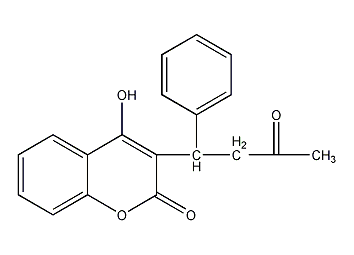Warfarin


Structural formula
| Business number | 01SE |
|---|---|
| Molecular formula | C19H16O4 |
| Molecular weight | 308.33 |
| label |
Warfarin, 4-hydroxy-3-(3-oxo-1-phenylbutyl)-2H-1-benzopyran-2-one, rat killer, Brumolin, Coumafen, Dethmor, Kumadu, Rodafarin, 4-Hydroxy-3-(3-oxo-1-phenylbutyl)-2H-1-benzopyran-2-one, Rodenticide |
Numbering system
CAS number:81-81-2
MDL number:MFCD00006854
EINECS number:201-377-6
RTECS number:GN4550000
BRN number:8868198
PubChem number:24890636
Physical property data
1. Properties: Colorless, odorless and tasteless crystals.
2. Density (g/mL, 25/4℃): Uncertain
3. Relative vapor density (g/mL, air=1): Uncertain Determine
4. Melting point (ºC): 159~161℃
5. Boiling point (ºC, normal Pressure): Uncertain
6. Boiling point (ºC, 5.2kPa): Uncertain
7. Refractive index: Uncertain
8. Flash point ( ºC): Uncertain
9. Specific optical rotation (º): Uncertain
10. Autoignition point or ignition temperature (ºC): Uncertain
11. Vapor pressure (kPa, 25ºC): Uncertain
12. Saturated vapor pressure (kPa, 60ºC): Uncertain
13. Heat of combustion (KJ/mol): Uncertain
14. Critical temperature (ºC): Uncertain
15. Critical pressure (KPa): Uncertain
16. Oil and water (octanol/ Log value of the partition coefficient (water): Uncertain
17. Explosion upper limit (%, V/V): Uncertain
18. Explosion lower limit (%, V/V): Uncertain
19. Solubility: Easily soluble in alkali aqueous solutions, soluble in acetone, dioxane, moderately soluble in methanol, ethanol, isopropyl alcohol and some oils, insoluble in water , benzene, cyclohexane.
Toxicological data
The oral LD50323 for male rats, female rats, mice and rabbits respectivelymg/kg, 58mg/kg, 374mg/kg, about 800mg/kg; It has also been reported that the oral LD50 of male rats and female rats: 100.3mg /kg, 8.7mg/kg. It is less toxic to poultry such as chickens, ducks, cattle, and sheep, and is less toxic to pigs, dogs, and cats. More sensitive.
Ecological data
None yet
Molecular structure data
1. Molar refractive index: 84.44
2. Molar volume (cm3/mol): 235.7
3. Isotonic specific volume (90.2K ): 652.4
4. Surface tension (dyne/cm): 58.6
5. Polarizability (10-24cm3): 33.47
Compute chemical data
1. Reference value for hydrophobic parameter calculation (XlogP): None
2. Number of hydrogen bond donors: 1
3. Number of hydrogen bond acceptors: 4
4. Number of rotatable chemical bonds: 4
5. Number of tautomers: 9
6. Topological molecule polar surface area 63.6
7. Number of heavy atoms: 23
8. Surface charge: 0
9. Complexity: 502
10. Number of isotope atoms: 0
11. Determine the number of atomic stereocenters: 0
12. Uncertain number of atomic stereocenters: 1
13. Determine the number of chemical bond stereocenters: 0
14. Number of uncertain chemical bond stereocenters: 0
15. Number of covalent bond units: 1
Properties and stability
None yet
Storage method
This product should be sealed and stored in a dry and dark place.
Synthesis method
1. Benzylideneacetone is synthesized from benzaldehyde and acetone, and then condensed with 4-hydroxycoumarin to prepare warfarin. The product includes 98% raw powder, 2.5% mother powder and 0.025 poison bait. Pure powder is made of starch and raw powder evenly mixed. Poison baits are made from grains such as corn flour, mixed with mother powder and warning colors, and then extruded and dried into strips. Wax block poison baits can also be made by mixing mother powder and paraffin.
2.Using salicylic acid as raw material, it is first esterified with methanol, then acylated with acetic anhydride at 40°C, and then in sodium metal. 4-Hydroxycoumarin can be synthesized by acidification under the action of chlorine; or 4-Hydroxycoumarin can be prepared from salicylic acid and thionyl chloride through acylation, cyclization and acidification. In addition, substituted butene[3]-ketone[2] is obtained by condensation of benzaldehyde and acetone in the presence of sodium hydroxide. Reflux the prepared 4-hydroxycoumarin and substituted butene-[3]-ketone-[2] in pyridine, acidify to pH about 2 with hydrochloric acid, Using salicylic acid as raw material, it is first mixed with methanol
Purpose
1. This product is an anticoagulant rodenticide that is widely used around the world. It is mainly used to kill domestic mice such as Mus musculus, Rattus rattus and Rattus norvegicus. It can also be used to kill wild mice. The mode of action of warfarin is that after entering the rat’s body, it exhibits an anticoagulant effect, causing the rat to bleed and die. Generally, the rodent eradication rate can reach more than 90% within three weeks after baiting. This product is also used as an oral anticoagulant. Warfarin sodium is used to prevent and treat thromboembolic diseases.
2.Anticoagulant rodenticide. After entering the rat body, the agent showed anticoagulant effect, causing the rat to bleed and die. It is mainly used to kill domestic rats such as Mus musculus, Rattus rattus, Rattus norvegicus, etc. It can also be used to kill wild rats.
